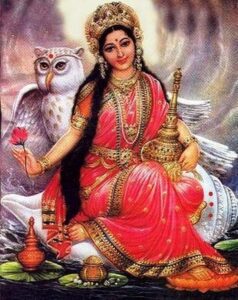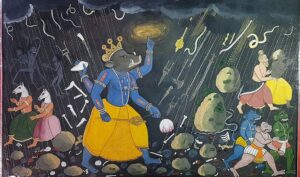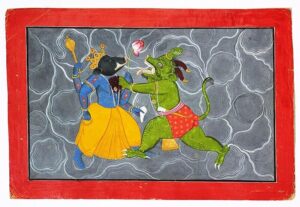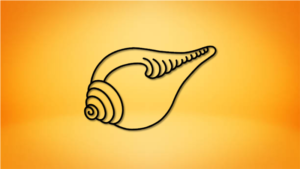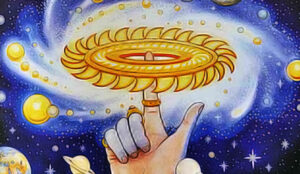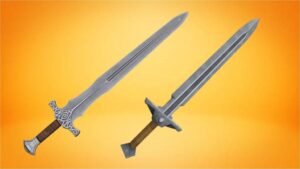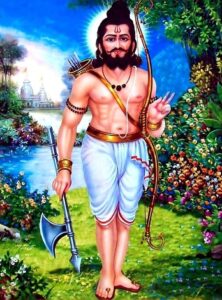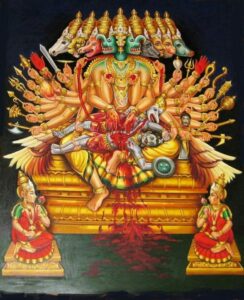Om Bhuvarahaya Vidmahe Hiranyakarbaya Dhimahi Thanno Kroda Prachodayata
Varaha is the third avatar of Lord Vishnu, in the form of a boar. Varaha lifts the earth goddess Bhumi (the earth) out of the cosmic ocean when the demon Hiranyaksha stole the earth and hid her in the waters, Vishnu appeared as Varaha to rescue her. Varaha killed Hiranyaksha and retrieved the earth goddess from the cosmic ocean, lifting it on his tusks, and restoring her to her place in the universe.
Varaha is completely a boar or with a boar’s head and the human body (an anthropomorphic form). His consort is Bhumi, the earth goddess. Varaha’s shakti (energy or consort) is the Matrika Varahi, who is also depicted with a boar head like the god.
Iconography
Varaha is often depicted as a free-standing boar colossus when in the zoomorphic form. The monolithic sculpture of Varaha in Khajuraho (c. 900–925) made in sandstone, is 2.6 metres (8 ft 6 in) long and 1.7 metres (5 ft 7 in) high is an example.

The earth personified as the goddess Bhumi, clings to one of Varaha’s tusks. Often the colossus is decorated by miniature figurines of deities, other celestial beings, sages, anthropomorphic planets, stars, and other world creatures appearing all over his body, which signify the whole of creation. The goddess of speech and knowledge, Sarasvati is often depicted on his tongue, while Brahma is often depicted on his head with Shiva and Parvati on his forehead and neck.
Varaha sculptures generally look up to the right; there are very rare instances of left-facing Varaha depictions.
Varaha has four arms, two of which hold the Sudarshana Chakra (discus) and Panchajanya (conch), while the other two hold a gada (mace), a sword, or a lotus or one of them makes the Varada mudra (gesture of blessing).
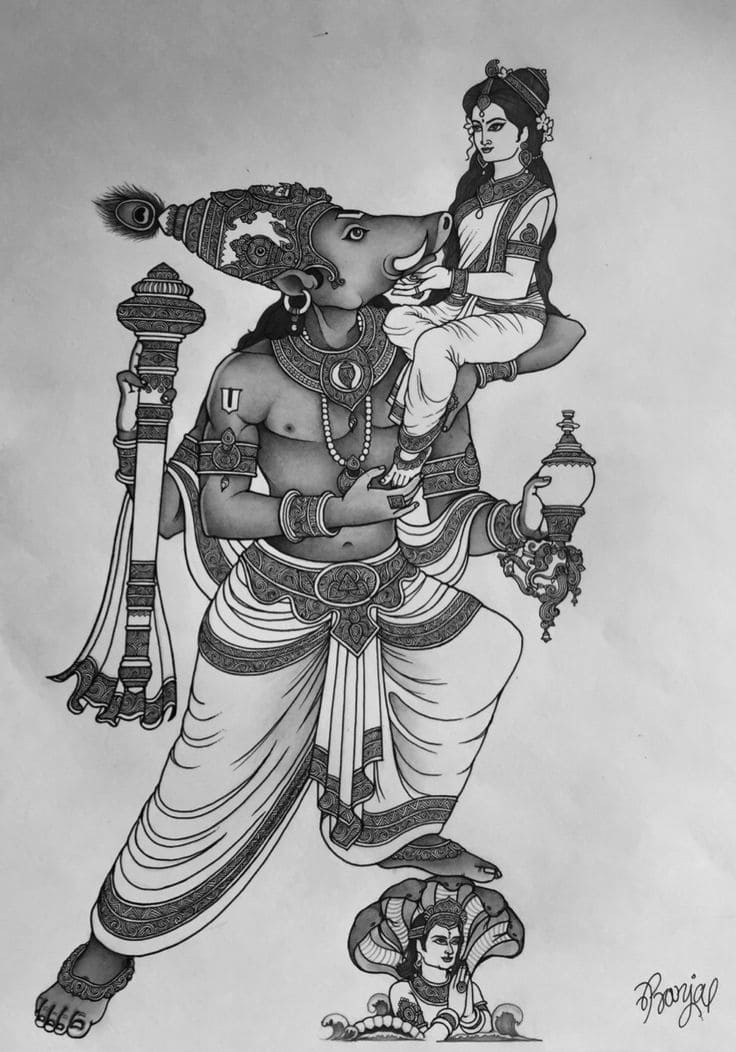
Sometimes, Varaha may carry only two of Vishnu’s attributes: a shankha and the gada personified as a female called Gadadevi. Varaha may also wear a vanamala (a garland of forest flowers). Varaha is often shown with a bulky physique and in a heroic pose. He is often depicted triumphantly emerging from the ocean as he rescues the earth.
The earth may be shown as the goddess Bhumi in sculpture which is often shown as a small figure in the icon. She may be seated on or dangling from one of Varaha’s tusks or is seated on the corner of his folded elbow or his shoulder and supports herself against the tusk or the snout, as being lifted from the waters.
In later Indian paintings, the whole earth or a part of it is depicted lifted by Varaha’s tusks. The earth may be portrayed as a globe, a flat stretch of mountainous land or an elaborate forest landscape with buildings, temples, humans, birds, and animals.
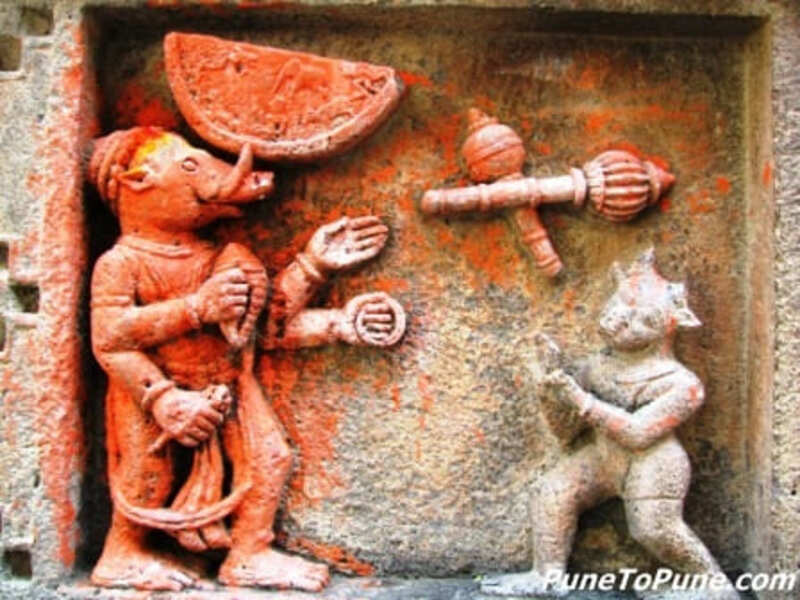
The defeated demon may be depicted trampled under Varaha’s feet or being killed in combat by Varaha. Nagas and their consorts Naginis, residents of the underworld, may be depicted as swimming in the ocean with hands folded as a mark of devotion. Varaha may be also depicted standing on a snake or other minor creatures, denoting the cosmic waters.
Sometimes, Lakshmi – Vishnu’s primary consort – is depicted in the scene near the right foot of Varaha.
Yajna Varaha – denoting yajna (sacrifice) – is seated on a lion throne and flanked by Bhumi and Lakshmi. As Pralaya Varaha – indicative of lifting the earth from the stage of the pralaya (the dissolution of the universe) – he is depicted only with Bhumi.

In the Vaikuntha Vishnu (four-headed Vishnu) images, the boar is shown as the left head.
Legends:
Varaha is originally described as a form of Prajapati (a form of Brahma), but on evolved into the avatar of Vishnu in later Hindu scriptures.
The Ayodhya Kanda book of the epic Ramayana refers to Varaha retaining his connection to Prajapati as Brahma. In a cosmogonic myth, Brahma appears in the primal universe full of water and takes the form of a boar to lift the earth from the waters; creation begins with Brahma and his progeny. The Yuddha Kanda book of the epic praises Rama (the hero of the epic, who is identified with Vishnu) as “the single-tusked boar”, which is interpreted as an allusion to Varaha and links Varaha with Vishnu.
In the epic Mahabharata, Narayana is praised as the one who rescues the earth as a boar.
The Brahmanda Purana, the Vayu Purana, the Vishnu Purana, the Linga Purana, the Markendeya Purana, the Kurma Purana, the Garuda Purana, the Padma Purana and the Shiva Purana have similar narratives of the cosmogonic myth, wherein Brahma, identified with Vishnu, takes the Varaha form to raise the earth from the primaeval waters.
The Brahmanda Purana narrates that in the present kalpa (“aeon”) called Varaha kalpa, Brahma wakes from his slumber. Brahma is called Narayana (“he who lies in the waters”).
The Agni Purana mentions the obliteration of the demon Hiranyaksha as Varaha’s main purpose.

The Linga Purana and the Kurma Purana narrate that the daitya Hiranyaksa defeats the gods and entraps the earth in the subterranean realm. Vishnu by taking the Varaha form slays the demon by piercing him with his tusks. Later, he uplifts the earth from the netherworld and restores her to her original position. The Linga Purana continues further: Later, Vishnu discards his boar body and returns to his heavenly abode of Vaikuntha; the earth cannot bear the weight of his tusks. Shiva relieves the earth by using the same as an ornament.

Bhagavata Purana narrates that Jaya and Vijaya, the doorkeepers of Vishnu’s abode Vaikuntha, were cursed by the four Kumaras to be born as demons. In their first birth, they are born as the daityas Hiranyakashipu (who is slain by another of Vishnu’s avatar of Narasimha) and Hiranyaksha as the twin sons of Diti and the sage Kashyapa.
The Brahma Purana narrates another tale where a rakshasa (demon) named Sindhusena defeated the gods and took the sacrifice to the netherworld Rasatala. Implored by the gods, Vishnu takes the form of Varaha and enters Rasatala. He slew the demons and recovered the sacrifice holding it in his mouth (mukha), so the sacrifice is known as makha.
The Vishnu Purana, the Brahma Purana and the Bhagavata Purana, in the episode of the killing of the demon Narakasura by the Krishna avatar of Vishnu, mention that he was the foster son of Varaha and the earth goddess Bhumi. In some versions of the tale, Vishnu-Varaha promises the earth that he will not kill their son, without any consent. In Krishna form, Vishnu slays the demon with the support of Satyabhama, Krishna’s consort and the avatar of Bhumi.
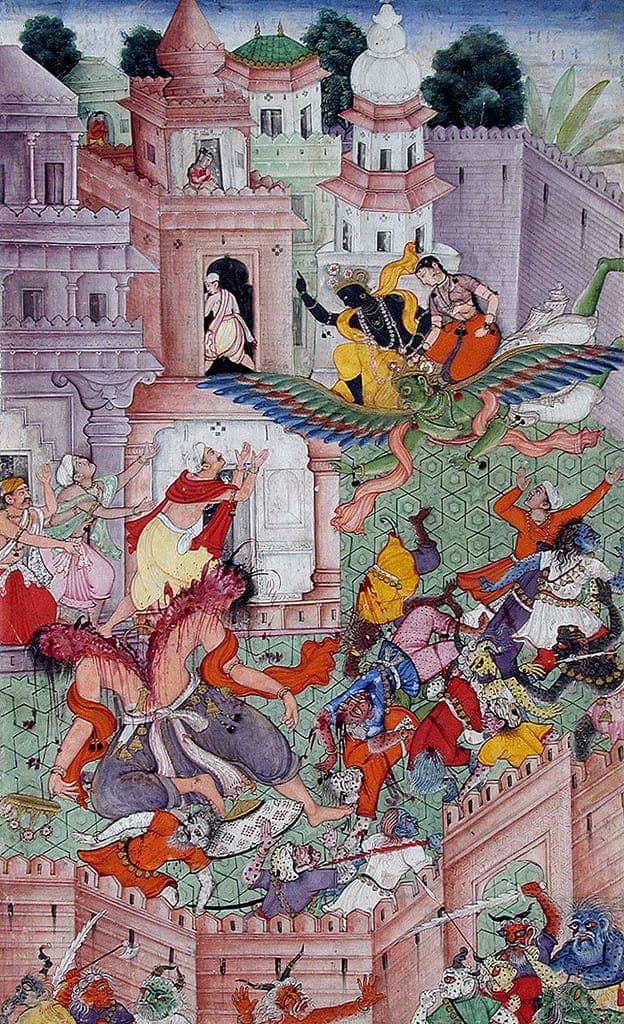
The Avantikshetra Mahatmya of the Skanda Purana states that after slaying Hiranyaksha, the Shipra River springs from the heart of Varaha. Thus, the sacred river is described as the daughter of Varaha.


